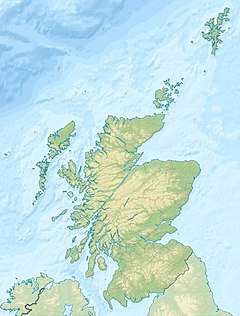Fidra lighthouse
| Gaelic name | Fiodra |
|---|---|
| Norse name | Fiðrey |
| Meaning of name | Norse for "feather island" |
 Fidra |
|
| Location | |
|
Fidra shown within Scotland
|
|
| OS grid reference | NT5186 |
| Coordinates | 56°04′N 2°47′W / 56.07°N 2.78°W |
| Physical geography | |
| Island group | Islands of the Forth |
| Area | c. 10 ha |
| Highest elevation | c. 20 m |
| Administration | |
| Sovereign state | United Kingdom |
| Country | Scotland |
| Council area | East Lothian |
| Demographics | |
| Population | 0 |
| References | |

Fidra Lighthouse
|
|
|
Scotland
|
|
| Location | Fidra North Berwick Scotland United Kingdom |
|---|---|
| Coordinates | 56°04′24″N 2°47′06″W / 56.073219°N 2.785130°W |
| Year first constructed | 1885 |
| Automated | 1970 |
| Construction | brick tower |
| Tower shape | cylindrical tower with balcony and lantern |
| Markings / pattern | white tower, black lantern, ochre trim |
| Height | 17 metres (56 ft) |
| Focal height | 34 metres (112 ft) |
| Light source | mains power |
| Range | 24 nautical miles (44 km; 28 mi) |
| Characteristic | Fl (4) W 30s. |
| Admiralty number | A2868 |
| NGA number | 2352 |
| ARLHS number | SCO-080 |
| Managing agent |
Forth Ports |
Fidra (archaically "Fidrey" or " Fetheray") is an uninhabited island in the Firth of Forth, 4 kilometres (2.5 mi) north-west of North Berwick, on the east coast of Scotland. The island is an RSPB Scotland nature reserve.
Like the other islands near North Berwick, Fidra is the result of volcanic activity around 335 million years ago. Fidra consists of three sections; a hill at one end with the lighthouse on it; a low-lying section in the middle, effectively an isthmus; and a rocky stack at the other end.
The island's name is believed to be Old Norse in origin, referring to the large number of bird feathers found there. Like the nearby Bass Rock, it has a substantial seabird population, and is now an RSPB reserve. The village of Gullane lies to the south-west, and the nature reserve of Yellowcraig and village of Dirleton, to which parish Fidra belongs, are to the south. Remotely operated cameras on the island send live pictures to the watching visitors at the Scottish Seabird Centre in North Berwick.
Upon the island are ruins of an old chapel, or lazaretto for the sick, which was dedicated in 1165 to St Nicholas. In the 12th-century, the island formed part of the barony of Dirleton, which was granted to the Anglo-Norman John de Vaux by King David I. The de Vaux family built a stronghold, known as Tarbet Castle, on the island, but in 1220, William de Vaux gifted Fidra to the monks of Dryburgh Abbey, in the Borders. His successor built Dirleton Castle, on the mainland, as a replacement dwelling.
...
Wikipedia


